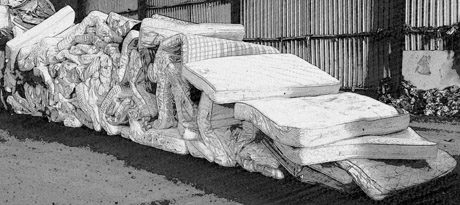
The National Bed Federation, the trade association representing UK (and Irish) bed manufacturers and their component suppliers, has published its second report on the fate of mattresses at the end of their usable life.
Produced on behalf of the NBF by environmental consultants Oakdene Hollins, the 2016 End of Life (EoL) Mattress Report updates and improves the previous, 2014, report on the current state of mattress recycling/re-use in the UK. It provides quantified levels of recycling as well as indicating where the trends in this area are heading.
Says Tony Lisanti, group chief executive of the Airsprung Furniture Group and chair of the NBF Recycling Group: “We hope this document will become the prime repository, by some considerable way, for academic research into this area and that anyone seriously interested in the matter of mattress recycling will naturally be guided to the NBF. We expect this work to allow us to engage meaningfully with legislators, ensuring our thoughts are properly considered when legislation in this area is drawn up – as it inevitably will be in future.”
Collating data mainly for 2014, the report estimates that of some 5.9 million EoL mattresses, weighing an estimated 148,000 tonnes, 16% were recycled, 11% incinerated for energy recovery and 73% landfilled. The vast majority of these – 88% come via local authorities, with the remainder originating in take-back schemes run by retailers and manufacturers. Although the figures are not directly comparable to the first NBF report, due to improved methodology and different mattress weight calculation, the overall upward trend in recycling rates is real – indicating a 20% increase in recycling rates by local authorities; 27% by manufacturers and 10% by retailers.

However the report identifies a number of stresses and strains on mattress recycling which indicates that this upward trend may not be sustained in 2015 and 2016 figures. These include costs of collection and dismantling still comparing unfavourably to landfill costs; and a squeeze on mattress recycling capacity as companies struggle to either address health & safety and other compliancy issues; or to make any money from or even to find markets for recovered materials. Reported recycling rates in different regions are extremely variable, with the availability of good quality local recyclers identified as the greatest barrier after cost constraints.
The reports makes a number of recommendations, including the setting up of a forum or association for stakeholders in mattress recycling as well as recyclers themselves, to help promote and develop the sector, along with the development of independent audit processes and new quality standards for the processing of secondary materials. Other suggestions include the setting up of standard reporting protocols for mattress reuse and recycling.
Mr Lisanti concludes: “On a very practical basis we want to use the research and subsequent analysis to provide NBF members with options for the ethical, environmentally acceptable and cost effective approach to Product Stewardship and, within that, the disposal of EoL mattresses. Amongst our aims is to work with the recycling industry to ultimately be in a position whereby the NBF will endorse a network of mattress recyclers that conforms to an audited code of practice.”
The report can be accessed online at www.nbfrecycle.org.uk.






